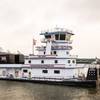In the first application of its type in marine propulsion, a Norwegian fjord ferry is to use LNG (liquefied natural gas)-fueled engines as the prime movers for a gas-electric powering and drive system. While primarily an environmental initiative, the use of the 'clean' energy source also holds out the prospect of reduced engineering maintenance outgoings over the long-term.
Although Scandinavia remains in the vanguard of 'lean-burn' technology, the plant for the 312 ft. (95-m), double-ended RoRo passenger ferry for operation in the western county of More & Romsdal will be of Japanese origin. It is claimed that the Mitsubishi gas engines, burning LNG derived from North Sea oil production, will produce 90 percent less nitrogen oxide (NOx) emissions relative to a diesel plant of comparable output.
Certain local marine equipment suppliers, witnessing a Japanese success in their own backyard, are skeptical as to the future scope for such installations. Certainly, there is a premium to be paid, and fundamental logistic considerations prevail as regards ensuring LNG bunkers supply.
However, others in the industry believe that Norway's vital coastal and fjord transportation infrastructure, married with the inevitable increase in local controls on atmospheric pollution from ferries and other shipping, will promote further investment along the lines of the More & Romsdal Fylkesbaater project. As in Sweden and Denmark, in particular, ferries have a very high environmental profile, due to constant operation within communities which have strong views on pollution matters. For the lightly populated Nordic countries, moreover, atmospheric pollution generated by shipping, particularly on a localized basis, is high relative to that produced by other activities.
For sure, the vessel's performance following scheduled delivery at the beginning of next year will be closely followed by the short-sea sector and Nordic ferry industry as a whole. The surge in uptake of selective catalytic reduction (SCR) devices for diesel plant and investment in other measures such as direct water injection (DWI) are indicative of vessel operators' recognition of the need to respond to increasingly stringent local and national controls inspired by environmental issues. Gas engines have intrinsic merits with regard to emissions performance, without the need for secondary measures, and a gas-electric system as specified for the new ferry confers the operational and design flexibility and space-saving benefits otherwise seen with the diesel-electric mode.
The double-ender has been ordered from Langsten Slip & Baatbyggeri, well known for its disposition towards the more challenging newbuild schemes. She has been dimensioned for 96 cars and 300 passengers.
Based in each case on a 12-cylinder Mitsubishi Vee engine driving a 650 kW generator, the four genset modules will be arranged on deck, feeding electrical energy to a pair of propulsion motors. The genset modules will be put together at the Spikkestad production plant of Norwegian company Diesel Power. It is anticipated that the vessel's regular service schedule, on a characteristically short fjord crossing, will require just two aggregates to be fired-up, leaving one engine as a standby, and a fourth under maintenance in a rolling program whereby machinery upkeep can be undertaken without prejudicing vessel availability.
Niche know-how
Pivotal to the quantification of new oilfields and, increasingly, to the fuller exploitation of existing or marginal accumulations, offshore seismic survey has become an intensely-competitive niche business in its own right. Performance levels set by the demands and expectations of the client industry have been driven still higher by the operators' need to achieve unprecedented productivity from costly vessels incorporating multi-streamer arrays and the most technologically advanced data handling capabilities.
The 1999 first-half has witnessed a considerable strengthening in the fleet purpose-designed for the task of seismic survey, undertaken in often hostile environmental conditions and in an ever-more demanding commercial market. The latest surge of investment has been dominated by Norwegian yards and equipment suppliers, underscoring the range and depth of the Norwegian maritime industrial infrastructure.
At a time when the shipbuilding industry's forward workload gives rise to immediate-term concerns over production continuity, the clutch of recent deliveries of new-generation seismic ships testifies to the reserves of design and build know-how and scope of indigenous equipment and machinery supply available on Norway's Atlantic fringe.
While the U.S. influence on the business is manifested in the commissioning of the 16-streamer Western Trident from Ulstein Verft, Norwegian-based operators PGS and Geco-Prakla have bolstered capacity with 20-streamer newbuilds from the Langsten and Mjellem & Karlsen yards, respectively.
The designs reflect the trend in demand towards wider tows, bigger arrays and longer streamers in 3-D exploration work, and the requirement for dense blanket coverage for the high-resolution 3-D market. These remarkable ships embody efficient hulls formed to accommodate the aft-deck concentration of the tools of the trade and to provide stable working platforms in the most rigorous sea conditions. They have been engineered for high maneuverability and for the minimum noise and vibration interference with the central role of data gathering.
The industry's ability to demonstrate the kind of innovation and technological capability which bears directly on frontline economics is evident in the fact that the cost of undertaking 3D seismic survey has been progressively cut from some $25,500 per sq. km in 1990 to around just $2,000 per sq. km now. In addition, survey assignment time has typically been cut from about two years to barely two months or less over the same period.
While the delta-shaped Ramform design, home-grown in Norway and used by PGS for the sextet of Ramform Explorer-class vessels from the Langsten group, is a mark of innovation in the field, the recently-delivered Geco Eagle has also introduced a distinctive new configuration to a vital offshore activity.
The 10,500-gt, diesel-electric Geco Eagle has become the flagship in the 27-strong fleet controlled by Geco-Prakla, the seismic operating unit of Schlumberger Oilfield Services. The distinguishing feature of the 312 ft. (95-m) vessel is the lateral extension of the main deck structure aft, providing the requisite 'back-deck' width for the multi-streamer gear and associated equipment while ensuring a more hydrodynamically-efficient stern. The twin-skeg, relatively shallow underwater aft form has been designed to minimize noise, given the need for quality data obtainable from the survey hydrophones.
Constructed in Bergen by Mjellem & Karlsen, among the world's most prolific builders of survey vessels, Geco Eagle has an outfit of 16 streamer winches on the main deck aft, with provision for the tow to be increased to 20 streamers through deployment of lead-in winches either side of the gun deck.
Sponsored Content
Lower carbon intensity fuels to support your operations

Subscribe for
Maritime Reporter E-News
Maritime Reporter E-News is the maritime industry's largest circulation and most authoritative ENews Service, delivered to your Email five times per week










